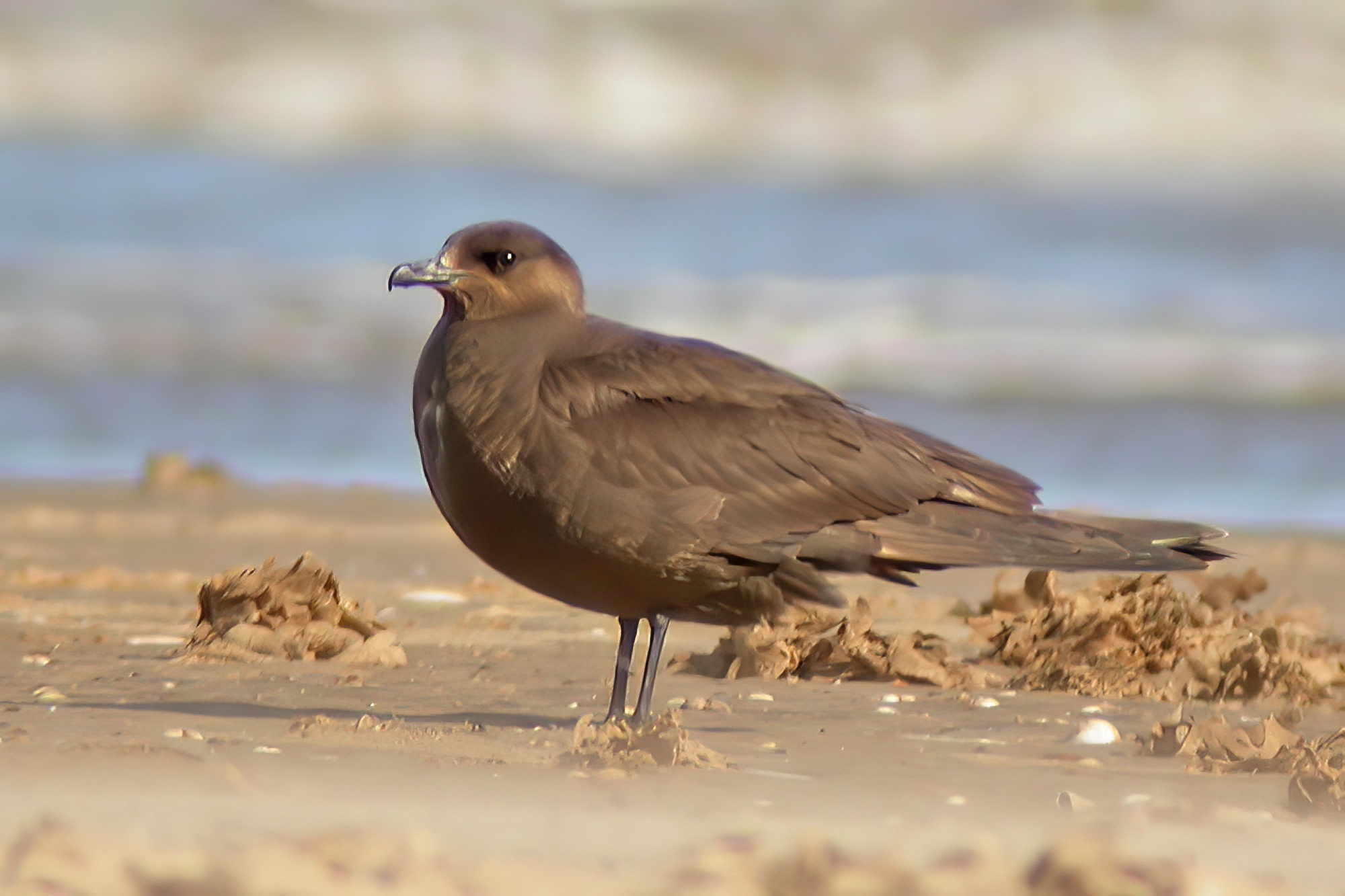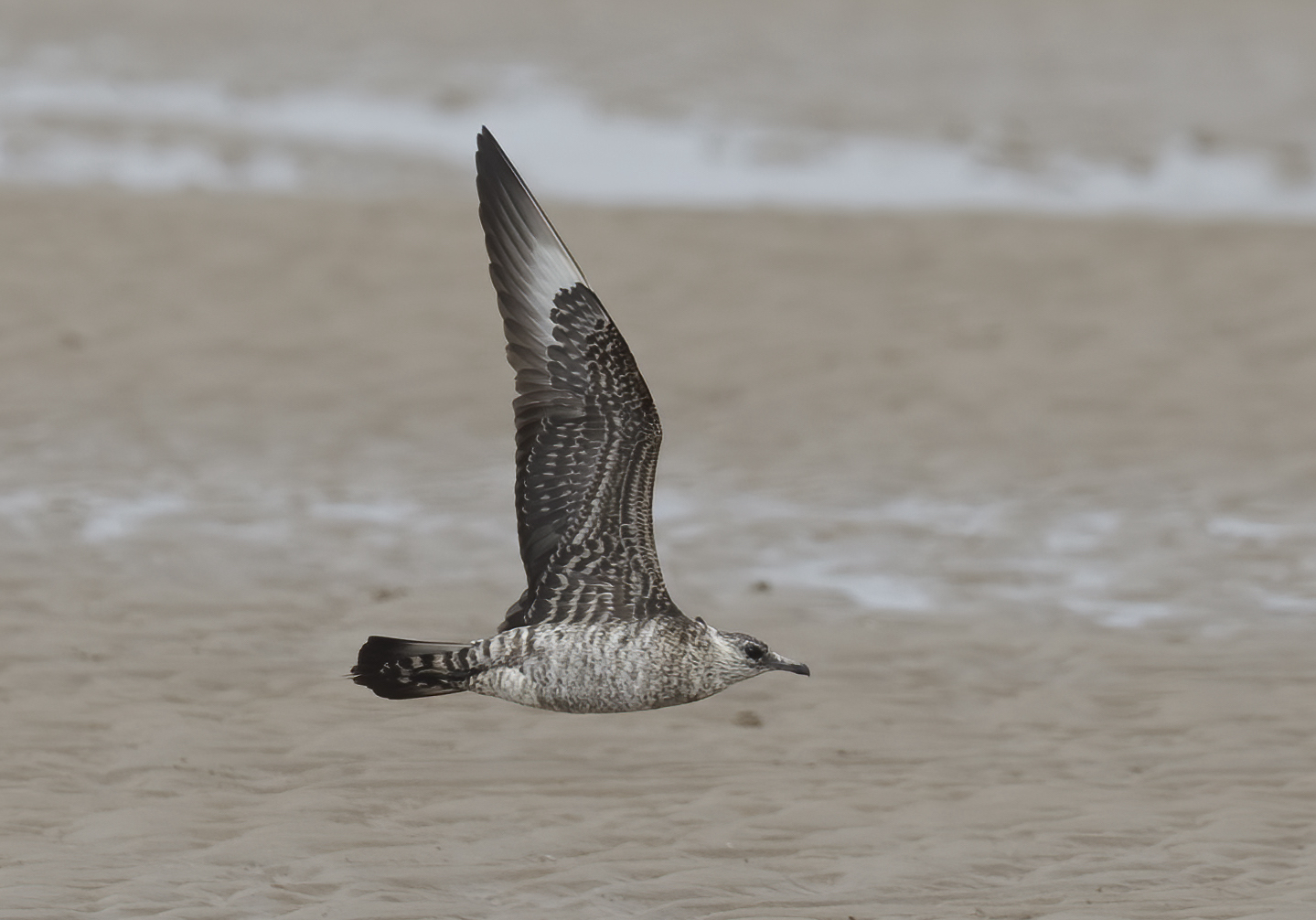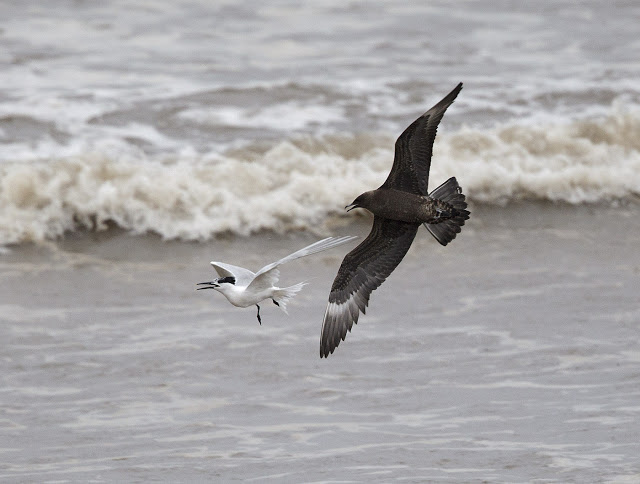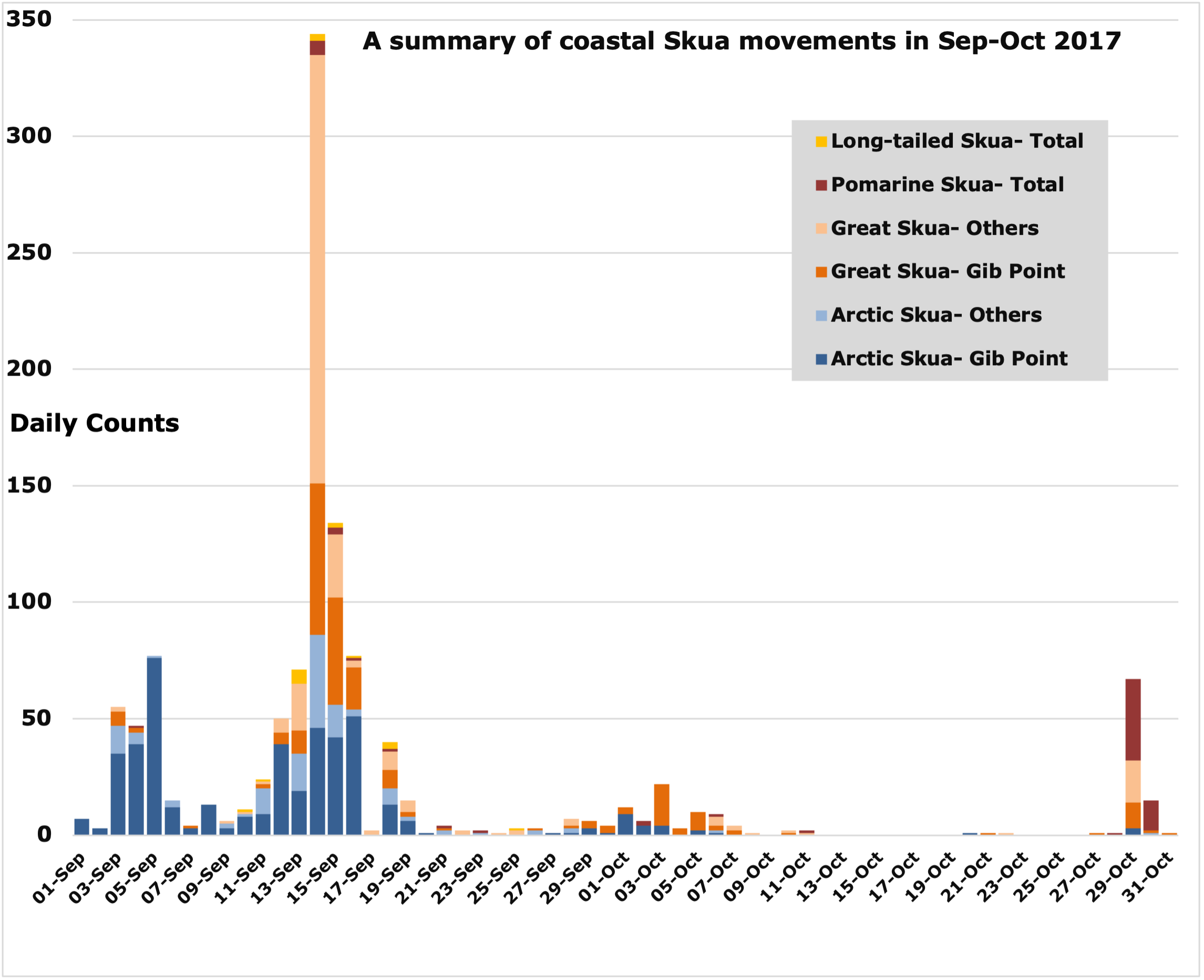Arctic Skua Stercorarius parasiticus
Fairly common, but decreasing, late summer and autumn passage migrant, mainly July to October. Very scarce in spring and winter and exceptional inland.



According to the Seabird Monitoring Programme UK breeding Arctic Skuas have crashed by 70% over the period 2000-2018. Certainly, migrants off the Lincolnshire coast have declined too. The Atlas referred to numbers of several hundred per day in the 1980s-90s but in the 5-year period to 2018 nothing like that has been observed. Illustrative records from various LBRs show that annual totals of all-site peak monthly counts ranged from 130 in 2017 to 210 in 2014 with an average of around 180 per year. Autumn migration starts mid-July and tends to peak in late August to late September but continues through October and into November. The migration totals split by month in the 5-year period to 2018 are as follows: July (5%), August (31%), September (43%), October (16%) and November (2%). The largest single day counts were both from Gibraltar Point with 92 on August 26th, 2014 and 76 on September 5th, 2017 (see chart below) although the latter total was dwarfed by Great Skuas on that date.

Overland autumn skua passage from The Wash
by G. M. S. Easy
Note: This account is based on the article which first appeared in Lincolnshire Bird Report, 1993; the table below is an update provided by the author and published in the 1995 report.
The phenomenon of skua migration from The Wash has frequently been documented in the Cambridge Bird Reports. In the 1990 edition the results of my observations at the Ouse mouth in Norfolk were summarised when a special effort was made to gauge the scale of these overland movements during one autumn. This showed that the volume of skua passage inland was not dissimilar from the movements observed off the Wash outh, Holme-Hunstanton (which is traditionally a heading into The Wash during gale-force NW winds). This suggested that the movement passing Hunstanton was of birds intent upon overland migration from the south Wash. The reason for the interest of Cambridge observers is that skuas are only occasionally spotted in that county due to the high flight paths taken by the majority of the skuas. This survey was an attempt to evaluate the extent of skua passage involved. The results were rather surprising, with 528 skuas (360 Arctic, 167 Great and one Long-tailed) counted departing from the south Wash on a Cambridgeshire heading during a total of 42 hr. watching, well below half the period when conditions were conducive to migration in daylight.
The autumn of 1993 was also targeted for a special survey of skua departures. After a spell of watching off the Ouse mouth a move was made to the Nene mouth inside the Lincolnshire boundary, where an exciting passage became apparent although not altogether duplicating the flow at the Ouse mouth. The Nene mouth was expected to provide significant skua departures since during recent observations off Lynn Point, skuas could be seen heading on this course and there was past information of inland departures from there, including a spectacular lift-off from the sea of 150 on September 14th, 1980. Furthermore, sightings of skuas over Wisbech Sewage Farm in earlier years suggested that this would be an easier route to track birds in Cambridgeshire. In reality, 1993 showed something more distinctive. There was a high level, purely migrational movement on a SW heading, often in cloud and involving terns, waders and skuas, which was not promoted by any surface features.
One surprising feature of the tern and skua movements was that these were already at high levels prior to reaching the shoreline. During the autumn I spent some 60 hr. attempting to pick out these departures, often in very poor visibility, in abominable conditions, and in a wide range of weather conditions in an attempt to evaluate the weather responsible for them. I found estimation of heights difficult - at the extreme, Great Skuas were only just identifiable and these would have been the equivalent of over two miles out to sea if distant off Hunstanton Cliffs. Often birds went over in cloud at heights where quite large flocks only took up part of the image produced by the 15x65 binoculars which I used, and some may have been above the cloud base on occasions. However, 10,000 ft. would seem an unlikely flight path for migration and these flocks would give very little chance of being picked out once dispersed further inland.
I was only present for about half the time that major movements were in progress, although the site was visited on most of those days of major skua departures. Even during these watches some flocks must have passed unobserved The high level of the arrival at the southern Wash suggested that birds had been travelling some distance at this height and may account for some of the daily counts of skuas from there exceeding counts at both Skegness and Hunstanton. High level migration has long been known to be a feature of skua migration. The Handbook (Witherby 1941) states that ‘migratory flights along coasts or overland are performed high in the air, so that even on a regularly followed route birds are easily missed unless watched for’. Certainly, I had not considered this factor as a possibility at other coastal observation points and have never felt the need to cloud watch during skua movements at Holme or Hunstanton in the past. The counts in the tables show the extent of SW movement compared to the whole inland skua departures.
Earlier watches at the Ouse mouth had produced 101 Arctic, 11 Great and one Pomarine Skuas, so my total count of skuas passing inland from the southern Wash in 1993 was nearly 800 birds. Some will have been missed as it was only possible to cover one or the two sites at any one time. The overall total number passing through is speculative but could be over 2000.
The migration at the Ouse mouth seems to involve birds which have already passed inland along the north Norfolk shoreline, those that have travelled parallel to the eastern Wash coast, and birds from the NW which may have passed Gibraltar Point. That at the Nene mouth involves birds which have passed high, unobserved or on a traditional heading close to the cliffs at Hunstanton, from the centre of The Wash or from the Lincolnshire side.
There remains two flight lines which don’t seem to be accounted for: the birds that are observed flighting parallel to the Lincolnshire coast, and a significant flight regularly observed off Holme and Hunstanton, of birds moving SW over Sunk Sand on a heading towards Boston Stump. This suggests that the SW corner and west side departure points of The Wash remain to be discovered.
| Great Skua | Arctic Skua | Pomarine Skua | Long-tailed Skua | |||||
| Year | A | B | A | B | A | B | A | B |
| 1993 | 218 | 151 | 357 | 144 | 105 | 59 | - | - |
| 1994 | 396 | 248 | 158 | 89 | 59 | 46 | 14 | 14 |
Nene mouth skua departures in 1993 and 1994; A = total number seen heading off inland; B = total number leaving on a SW heading.
(Account as per new Birds of Lincolnshire (2021), included September 2022)
